Energy and Spectral Efficiency Balancing Algorithm for Energy Saving in LTE Downlinks
Abstract
1. Introduction
2. Related Work
3. The Proposed SET Algorithm
3.1. Energy-Efficient Battery Lifetime Algorithm
3.2. Determination of Pareto Optimal Solution
| Algorithm 1 SE and EE Trade-off (SET) Algorithm for Saving Energy in Downlink LTE Networks |
 |
3.3. Energy Consumption of eNodeB Using Congested and Non-Congested Network Loads
4. Performance Evaluation of the Proposed SET Algorithm
4.1. Simulation Setup
4.2. Impact of Varying Traffic Loads in Non-Congested Network
4.3. Impact of Varying Traffic Loads in Congested Network
4.3.1. Impact of Varying Network Loads on a Congested Network Using an Omni-Directional Antenna
4.3.2. Impact of Varying Network Loads on a Congested Network Using a Directional Antenna
5. Conclusions
Author Contributions
Funding
Institutional Review Board Statement
Informed Consent Statement
Data Availability Statement
Acknowledgments
Conflicts of Interest
References
- Atayero, A.A.; Luka, M.K.; Orya, M.K.; Iruemi, J.O. 3GPP long term evolution: Architecture, protocols and interfaces. Int. J. Inf. Commun. Res. 2011, 1, 306–310. [Google Scholar]
- Holma, H.; Toskala, A. LTE Advanced: 3GPP Solution for IMT-Advanced; John Wiley & Sons: Hoboken, NJ, USA, 2012. [Google Scholar]
- Tung, L.P.; Wang, L.C.; Hsueh, C.W.; Chang, C.J. Analysis of DRX power saving with RRC states transition in LTE networks. In Proceedings of the 2015 European Conference on Networks and Communications (EuCNC), Paris, France, 29 June–2 July 2015; pp. 301–305. [Google Scholar]
- Tang, J.; So, D.K.; Alsusa, E.; Hamdi, K.A. Resource efficiency: A new paradigm on energy efficiency and spectral efficiency tradeoff. IEEE Trans. Wirel. Commun. 2014, 13, 4656–4669. [Google Scholar] [CrossRef]
- Chen, X.; Hu, R.Q.; Wu, G.; Li, Q.C. Tradeoff between energy efficiency and spectral efficiency in a delay constrained wireless system. Wirel. Commun. Mob. Comput. 2015, 15, 1945–1956. [Google Scholar] [CrossRef]
- Souza, Á.R.; Abrão, T.; Sampaio, L.H.; Jeszensky, P.J.E.; Pérez-Romero, J.; Casadevall, F. Energy and spectral efficiencies trade-off with filter optimisation in multiple access interference-aware networks. Trans. Emerg. Telecommun. Technol. 2015, 26, 670–685. [Google Scholar] [CrossRef]
- Abrão, T.; Sampaio, L.D.H.; Yang, S.; Cheung, K.T.K.; Jeszensky, P.J.E.; Hanzo, L. Energy efficient OFDMA networks maintaining statistical QoS guarantees for delay-sensitive traffic. IEEE Access 2016, 4, 774–791. [Google Scholar] [CrossRef]
- Son, K.; Oh, E.; Krishnamachari, B. Energy-efficient design of heterogeneous cellular networks from deployment to operation. Comput. Netw. 2015, 78, 95–106. [Google Scholar] [CrossRef]
- Song, Z.; Ni, Q.; Navaie, K.; Hou, S.; Wu, S. Energy-and spectral-efficiency tradeoff with alpha-fairness in downlink OFDMA systems. IEEE Commun. Lett. 2015, 19, 1265–1268. [Google Scholar] [CrossRef]
- Pervaiz, H.; Musavian, L.; Ni, Q.; Ding, Z. Energy and spectrum efficient transmission techniques under QoS constraints toward green heterogeneous networks. IEEE Access 2015, 3, 1655–1671. [Google Scholar] [CrossRef]
- Li, Z.; Jiang, H.; Pan, Z.; Liu, N.; You, X. Energy spectral efficiency tradeoff in downlink OFDMA network. Int. J. Commun. Syst. 2015, 28, 1450–1461. [Google Scholar] [CrossRef]
- Kim, M.G.; Kang, M.; Choi, J. Remaining energy-aware power management mechanism in the 802.16 e MAC. In Proceedings of the Consumer Communications and Networking Conference, Las Vegas, NV, USA, 10–12 January 2008; pp. 222–226. [Google Scholar]
- Richter, F.; Fehske, A.J.; Fettweis, G.P. Energy efficiency aspects of base station deployment strategies for cellular networks. In Proceedings of the Vehicular Technology Conference Fall (VTC 2009-Fall), Anchorage, AK, USA, 20–23 September 2009; pp. 1–5. [Google Scholar]
- Ling, L.; Wang, T.; Wang, Y.; Shi, C. Schemes of power allocation and antenna port selection in OFDM distributed antenna systems. In Proceedings of the Vehicular Technology Conference Fall (VTC 2010-Fall), Ottawa, ON, Canada, 6–9 September 2010; pp. 1–5. [Google Scholar]
- Isheden, C.; Fettweis, G.P. Energy-efficient link adaptation with transmitter CSI. In Proceedings of the Wireless Communications and Networking Conference (WCNC), Cancun, Mexico, 28–31 March 2011; pp. 1381–1386. [Google Scholar]
- Haider, F.; Wang, C.X.; Haas, H.; Hepsaydir, E.; Ge, X. Energy-efficient subcarrier-and-bit allocation in multi-user OFDMA systems. In Proceedings of the Vehicular Technology Conference (VTC Spring), Yokohama, Japan, 6–9 May 2012; pp. 1–5. [Google Scholar]
- Khakurel, S.; Musavian, L.; Le-Ngoc, T. Trade-off between spectral and energy efficiencies in a fading communication link. In Proceedings of the Vehicular Technology Conference (VTC Spring), Dresden, Germany, 2–5 June 2013; pp. 1–5. [Google Scholar]
- Coskun, C.C.; Ayanoglu, E. Energy-spectral efficiency tradeoff for heterogeneous networks with QoS constraints. In Proceedings of the Communications (ICC), Paris, France, 21–25 May 2017; pp. 1–7. [Google Scholar]
- Tsilimantos, D.; Gorce, J.M.; Jaffrès-Runser, K.; Poor, H.V. Spectral and energy efficiency trade-offs in cellular networks. IEEE Trans. Wirel. Commun. 2016, 15, 54–66. [Google Scholar] [CrossRef]
- Li, Z.; Jiang, H.; Li, P.; Pan, Z.; Liu, N.; You, X. Energy-Spectral-Efficiency Tradeoff in Interference-Limited Wireless Networks. Wirel. Pers. Commun. 2017, 96, 5515–5532. [Google Scholar] [CrossRef]
- Salman, M.I.; Mansoor, A.M.; Jalab, H.A.; Sabri, A.Q.M.; Ahmed, R. A Joint Evaluation of Energy-Efficient Downlink Scheduling and Partial CQI Feedback for LTE Video Transmission. Wirel. Pers. Commun. 2018, 98, 189–211. [Google Scholar] [CrossRef]
- ETSI. 3GPP TS 36.814 Evolved Universal Terrestrial Radio Access (E-UTRA); Further Advancements for E-UTRA Physical Layer Aspects (Release 9). 2010. Available online: https://portal.3gpp.org/desktopmodules/Specifications/SpecificationDetails.aspx?specificationId=2493 (accessed on 21 December 2020).
- Emmerich, M.; Deutz, A. Multicriteria Optimization and Decision Making Principles, Algorithms and Case Studies; LIACS, Leiden University: Leiden, The Netherlands, 2006. [Google Scholar]
- Coello, C.A.C.; Lamont, G.B.; Van Veldhuizen, D.A. Evolutionary Algorithms for Solving Multi-Objective Problems; Springer: New York, NY, USA, 2007; Volume 5, pp. 79–104. [Google Scholar]
- Marler, R.T.; Arora, J.S. Survey of multi-objective optimization methods for engineering. Struct. Multidiscip. Optim. 2004, 26, 369–395. [Google Scholar] [CrossRef]
- Lee, S.H.; Sohn, I. Distributed energy-saving cellular network management using message-passing. IEEE Trans. Veh. Technol. 2017, 66, 635–644. [Google Scholar] [CrossRef]
- Liu, L.; Xiong, A.; Yu, P.; Feng, L.; Li, W.; Qiu, X.; Wang, M. Energy-saving management mechanism based on hybrid energy supplies in multi-operator shared LTE networks. In Proceedings of the NOMS 2018-2018 IEEE/IFIP Network Operations and Management Symposium, Taipei, Taiwan, 23–27 April 2018; pp. 1–5. [Google Scholar]
- Auer, G.; Giannini, V.; Desset, C.; Godor, I.; Skillermark, P.; Olsson, M.; Imran, M.A.; Sabella, D.; Gonzalez, M.J.; Blume, O.; et al. How much energy is needed to run a wireless network? IEEE Wirel. Commun. 2011, 18, 40–49. [Google Scholar] [CrossRef]
- Jensen, A.R.; Lauridsen, M.; Mogensen, P.; Sørensen, T.B.; Jensen, P. LTE UE power consumption model. In Proceedings of the 2012 IEEE Vehicular Technology Conference (VTC Fall), Quebec City, QC, Canada, 3–6 September 2012; pp. 1–5. [Google Scholar]
- Wang, Y.C.; Hsieh, S.Y. Service-differentiated downlink flow scheduling to support QoS in long term evolution. Comput. Netw. 2016, 94, 344–359. [Google Scholar] [CrossRef]
- Elwekeil, M.; Alghoniemy, M.; Muta, O.; Abdel-Rahman, A.B.; Gacanin, H.; Furukawa, H. Performance evaluation of an adaptive self-organizing frequency reuse approach for OFDMA downlink. Wirel. Netw. 2017, 25, 507–519. [Google Scholar] [CrossRef]
- Tajika, Y.; Taoka, H.; Higuchi, K. 3GPP; TSG RAN; Requirements for further advancements for E-UTRA (LTE-Advanced) 3GPP; TSG RAN; Requirements for further advancements for E-UTRA (LTE-Advanced). IEICE Trans. Commun. 2008, 94, 3280–3288. [Google Scholar]
- Ikuno, J.C.; Wrulich, M.; Rupp, M. System level simulation of LTE networks. In Proceedings of the 2010 IEEE 71st Vehicular Technology Conference (VTC 2010-Spring), Taipei, Taiwan, 16–19 May 2010; pp. 1–5. [Google Scholar]


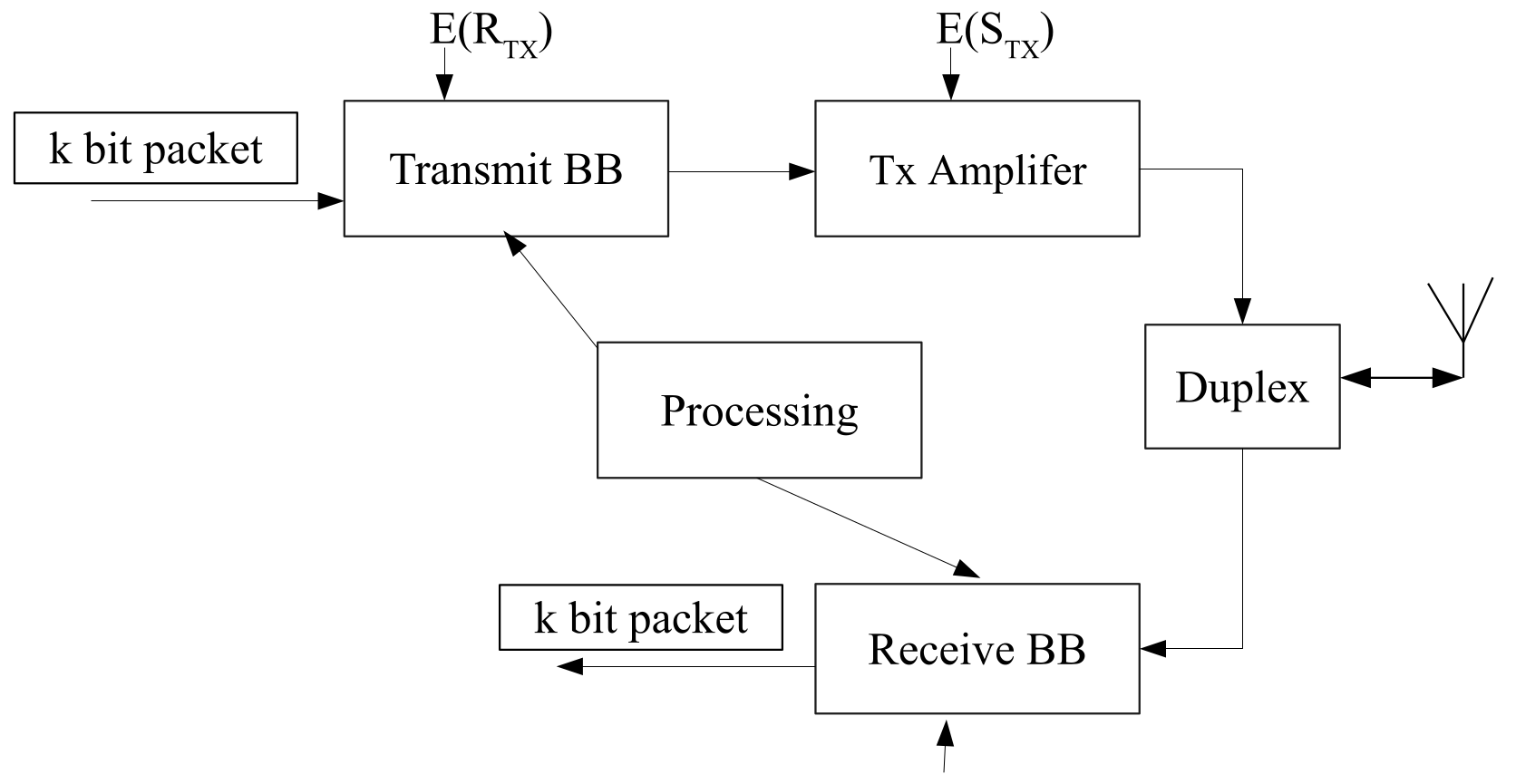
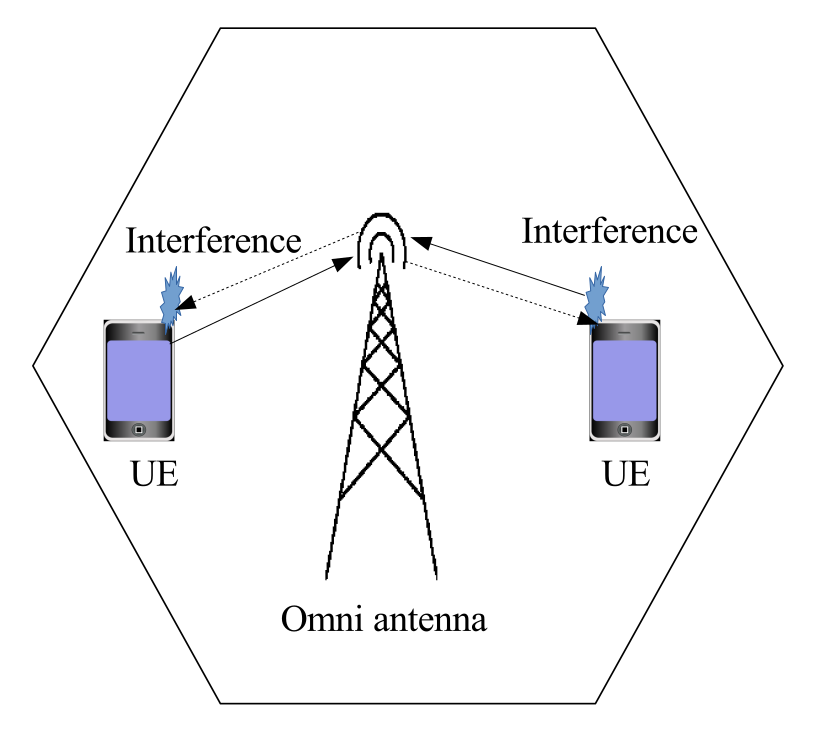

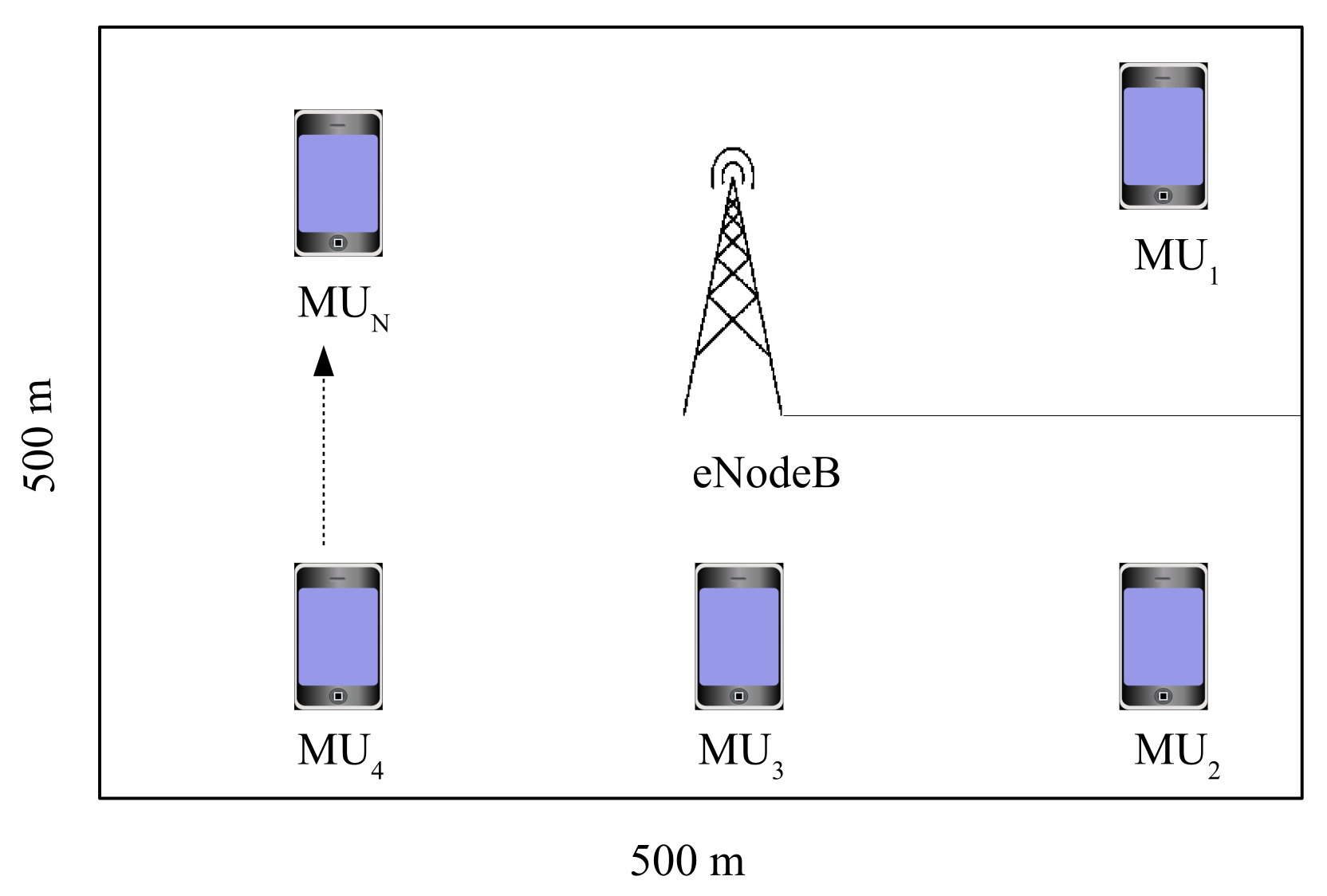
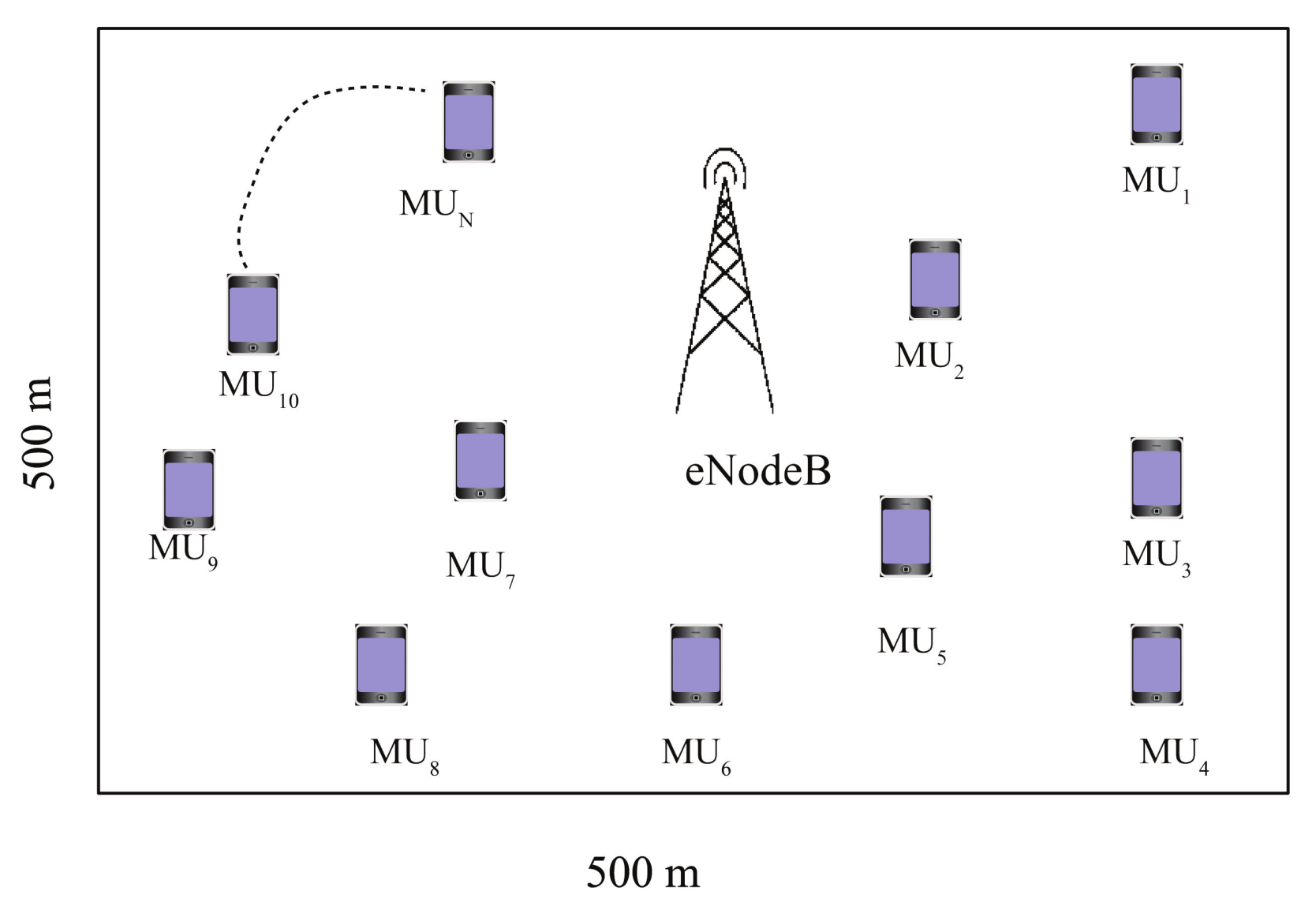
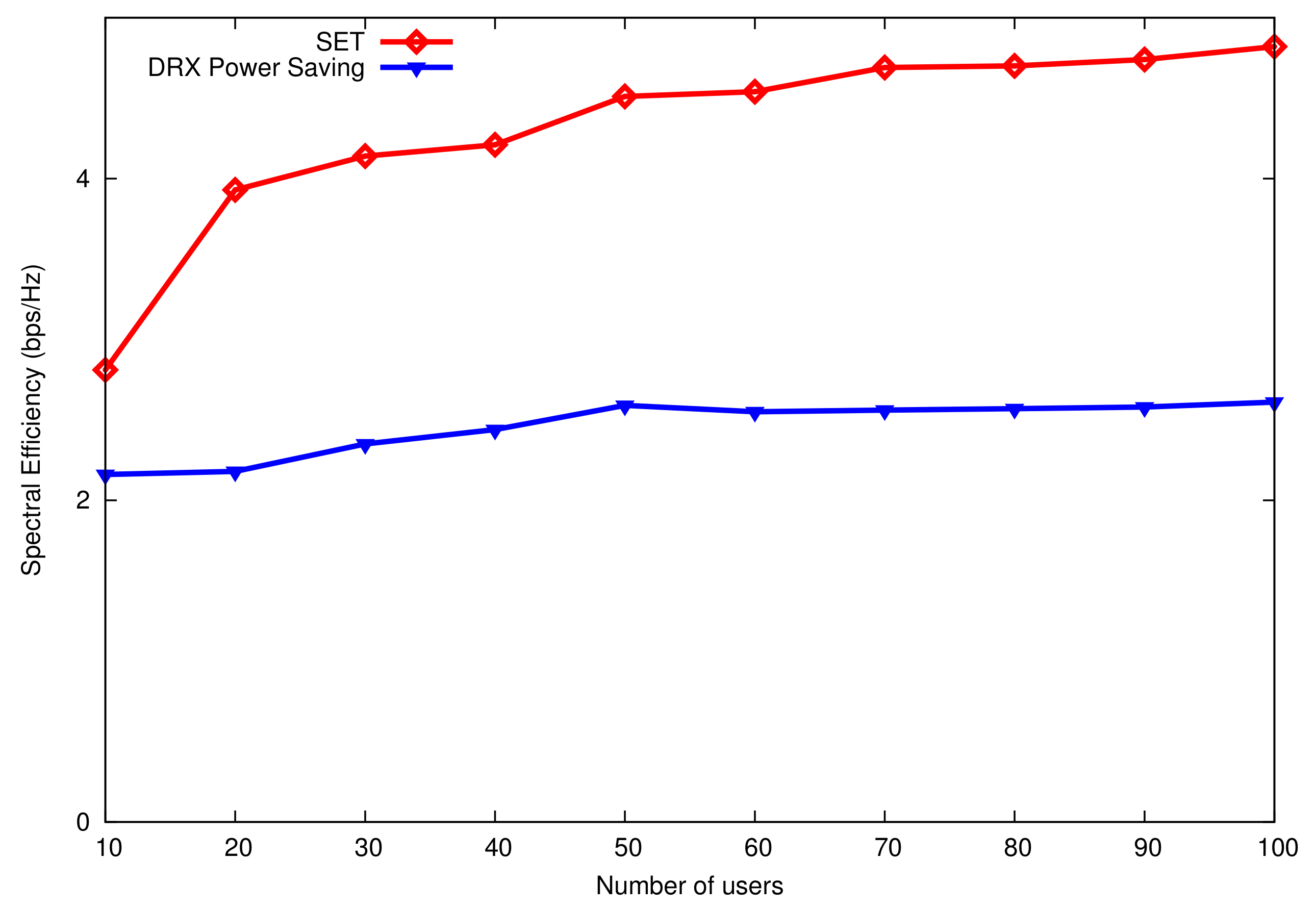
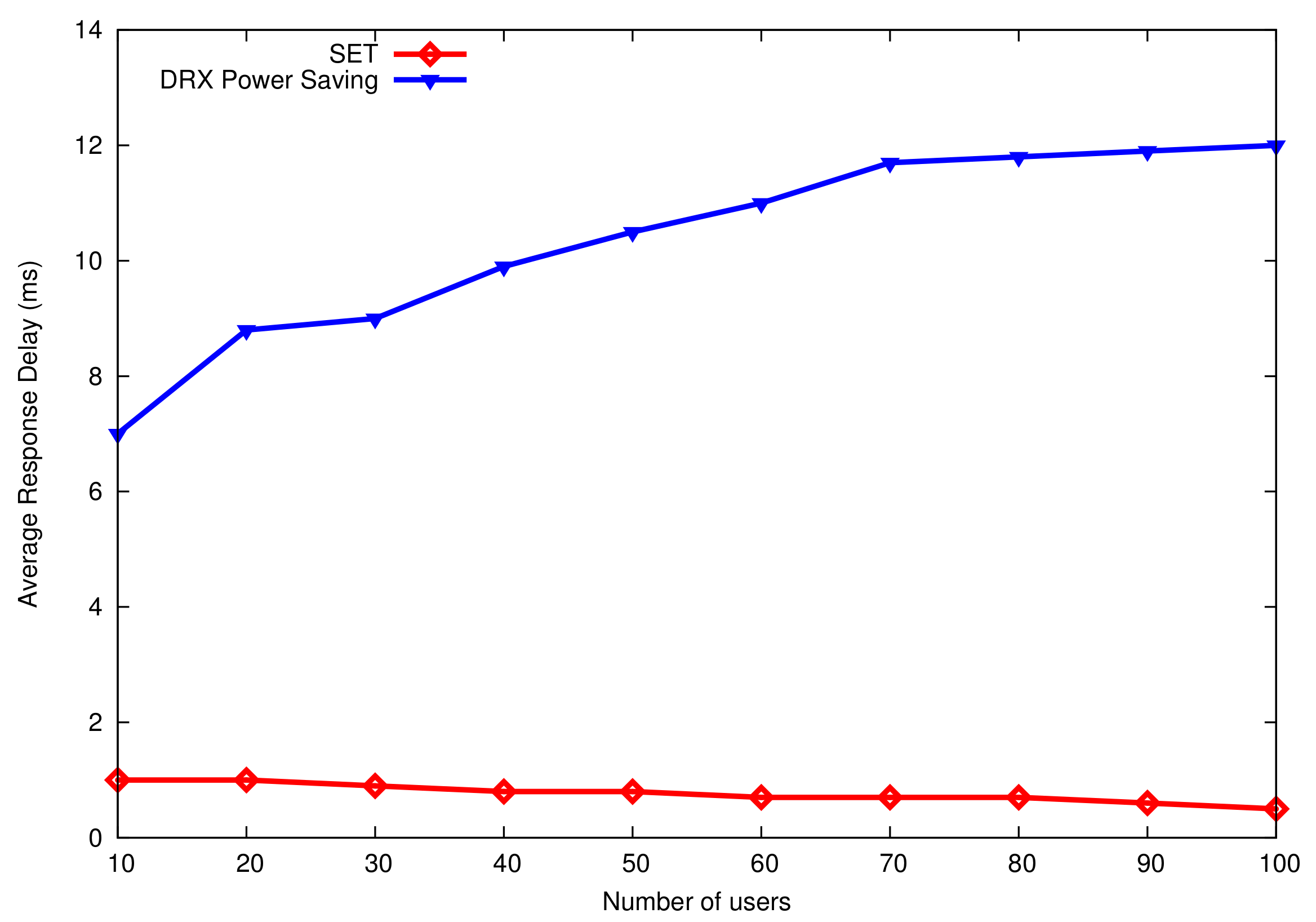
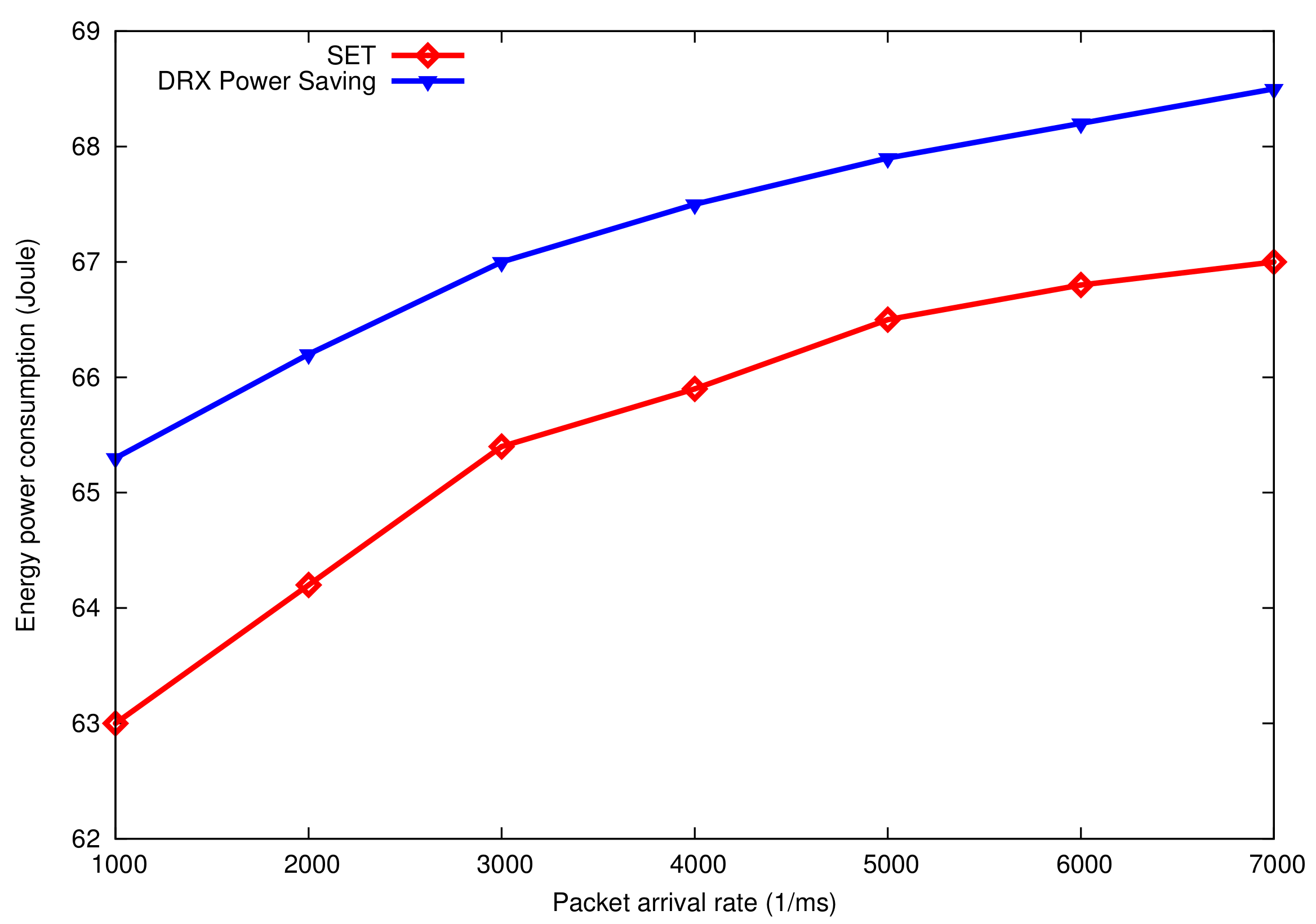


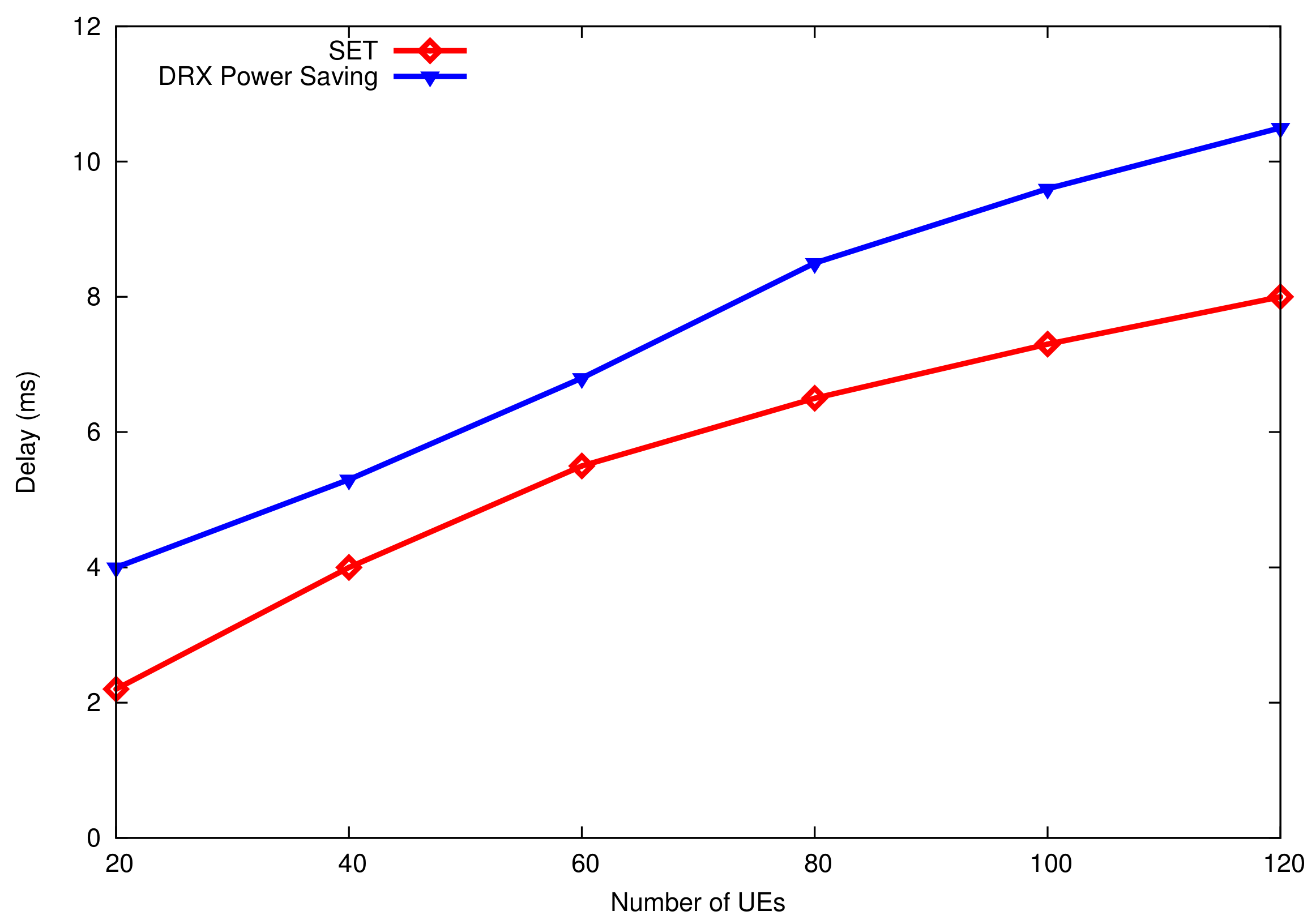
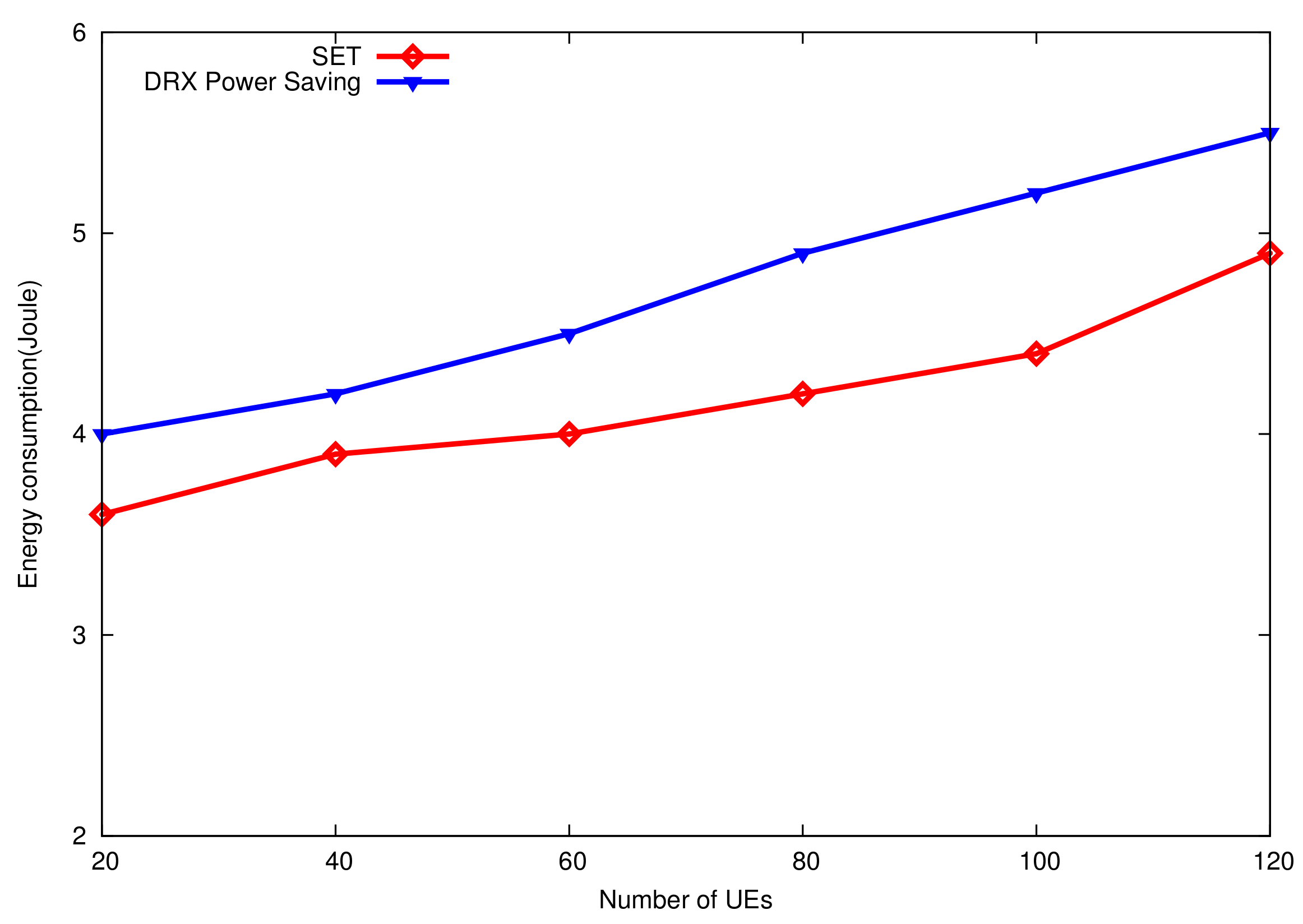
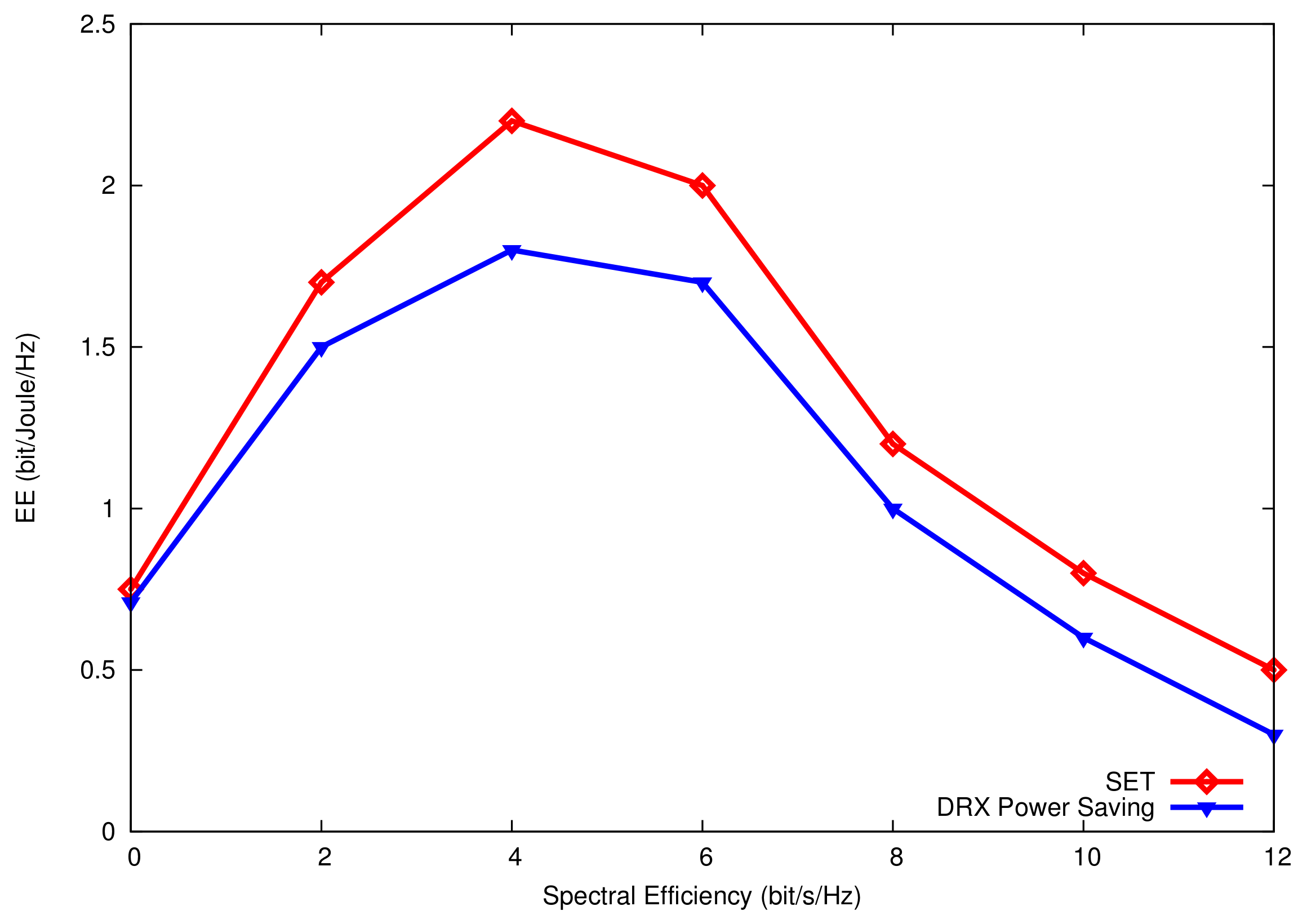



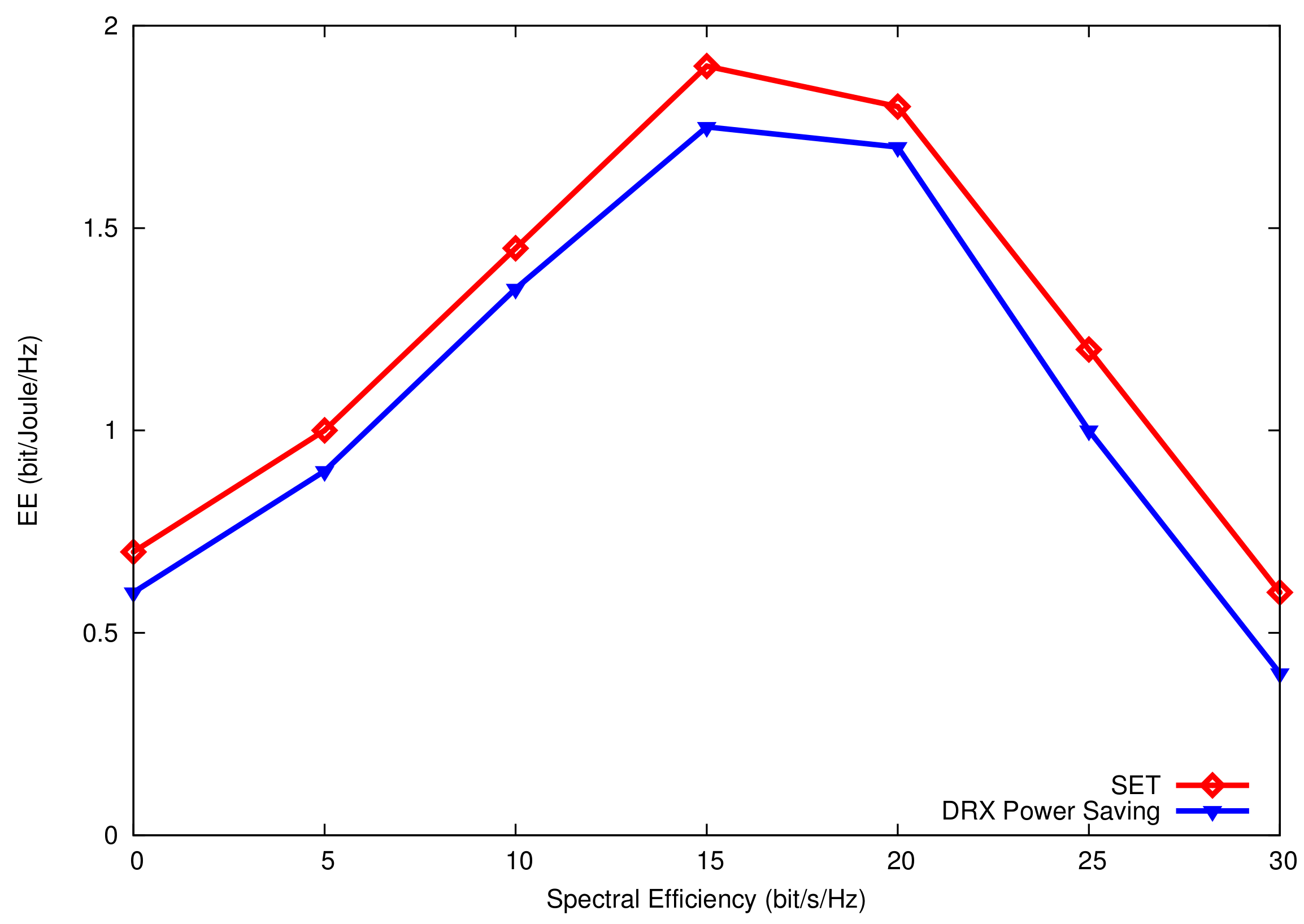
| Parameter | Value |
|---|---|
| System bandwidth | 5 MHz |
| Number of resource blocks | 25 |
| Active sector of concern | eNodeB2-sector1 |
| TTI | 1 ms; 1000 TTI per second |
| UE distribution | Uniform |
| Macroscopic path loss model | TS25814 |
| Simulation period | 100 s |
| Speed of the user | 4.16 m/s |
| Transmission scheme | 2 × 2 MIMO, OLSM |
| Cyclic prefix | Normal |
| Transmitter antenna gain | 18 dBi |
| Receiver antenna gain | 0 dBi |
| Maximum transmission power | 20 W |
| Maximum delay | 20 ms |
| Inter-eNodeB distance | 500 m |
Publisher’s Note: MDPI stays neutral with regard to jurisdictional claims in published maps and institutional affiliations. |
© 2020 by the authors. Licensee MDPI, Basel, Switzerland. This article is an open access article distributed under the terms and conditions of the Creative Commons Attribution (CC BY) license (http://creativecommons.org/licenses/by/4.0/).
Share and Cite
Maharazu, M.; Hanapi, Z.M.; Alrashah, M.A. Energy and Spectral Efficiency Balancing Algorithm for Energy Saving in LTE Downlinks. Symmetry 2021, 13, 211. https://doi.org/10.3390/sym13020211
Maharazu M, Hanapi ZM, Alrashah MA. Energy and Spectral Efficiency Balancing Algorithm for Energy Saving in LTE Downlinks. Symmetry. 2021; 13(2):211. https://doi.org/10.3390/sym13020211
Chicago/Turabian StyleMaharazu, Mamman, Zurina Mohd Hanapi, and Mohamed A. Alrashah. 2021. "Energy and Spectral Efficiency Balancing Algorithm for Energy Saving in LTE Downlinks" Symmetry 13, no. 2: 211. https://doi.org/10.3390/sym13020211
APA StyleMaharazu, M., Hanapi, Z. M., & Alrashah, M. A. (2021). Energy and Spectral Efficiency Balancing Algorithm for Energy Saving in LTE Downlinks. Symmetry, 13(2), 211. https://doi.org/10.3390/sym13020211






